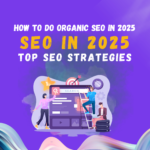
In the fast-paced world of digital marketing, staying ahead of the curve is essential for businesses looking to maintain their competitive edge. As we move into 2024, several key trends are emerging that will shape the landscape of digital marketing. From advancements in artificial intelligence to new social media strategies, these trends offer opportunities for businesses to innovate and enhance their marketing efforts.
In this blog, we will explore the top digital marketing trends for 2024, providing insights into how businesses can leverage these developments to stay ahead of the competition.
Table of Contents
ToggleArtificial Intelligence and Automation in Marketing
Artificial intelligence (AI) has been steadily gaining ground in digital marketing, and 2024 will see even more sophisticated applications. AI can analyze large volumes of data at a scale that humans simply cannot, enabling marketers to gain deeper insights into consumer behavior, preferences, and buying patterns.
Key applications of AI in marketing include:
Personalization: AI helps in delivering personalized content and experiences. For example, recommendation engines on e-commerce websites use AI to suggest products based on users’ browsing history and preferences.
Chatbots: Chatbots powered by AI are becoming more advanced, providing 24/7 customer service and assistance. By 2024, expect chatbots to handle even more complex interactions with a human-like level of sophistication.
Content Creation: AI tools like GPT-based systems are being used to generate high-quality content. While human creativity remains vital, AI can assist with generating ideas, drafting content, and even optimizing headlines.
Marketers who embrace AI and automation will see improved efficiency, reduced costs, and better targeting in their campaigns.
In this blog, we will explore the top digital marketing trends for 2024, providing insights into how businesses can leverage these developments to stay ahead of the competition.

Video Marketing Evolution
Video continues to dominate online content consumption, and its role in digital marketing will only grow in 2024. Short-form video content, like that seen on TikTok, Instagram Reels, and YouTube Shorts, has proven to be incredibly engaging. With attention spans shortening, businesses are focusing on bite-sized videos that can quickly capture the viewer’s attention.
Key trends in video marketing include:
Interactive Videos: Interactive content, such as shoppable videos or clickable links embedded within videos, is gaining popularity. This allows viewers to engage directly with the content, making it a more immersive experience.
Live Streaming: Live video continues to thrive, especially on platforms like YouTube, Facebook, and Twitch. Businesses are using live streaming for product launches, Q&A sessions, and behind-the-scenes content to create a real-time connection with their audience.
AI-Generated Video Content: AI tools that create and edit videos will be more accessible in 2024, allowing businesses to produce high-quality video content without a professional production team.
Video marketing offers a powerful way to communicate brand stories, showcase products, and engage with audiences on a deeper level.
Social Commerce and Shoppable Posts
Social media platforms are becoming more integrated with e-commerce, allowing users to shop directly from their feeds. In 2024, social commerce will continue to grow as platforms like Instagram, Facebook, Pinterest, and TikTok enhance their shopping features.
Key developments in social commerce include:
Shoppable Posts: Posts on Instagram and TikTok can now include direct links to product pages, allowing users to make purchases without leaving the app. This seamless shopping experience reduces friction and increases conversions.
Influencer Partnerships: Social commerce is being amplified by influencer marketing, where influencers create shoppable content. Their endorsements carry a level of trust that traditional ads often cannot, driving sales through authentic connections.
AI-Driven Shopping Recommendations: AI will be leveraged to provide personalized shopping experiences on social media platforms, offering users product recommendations based on their browsing behavior and preferences.
For brands, social commerce offers a significant opportunity to reach customers in the spaces where they spend the most time online.
Voice Search and Smart Speakers
With the rise of smart speakers like Amazon’s Alexa, Google Assistant, and Apple’s Siri, voice search has become a fundamental part of how consumers seek information. By 2024, voice search optimization will be an essential component of any digital marketing strategy.
Here’s how businesses can optimize for voice search:
Conversational Keywords: Unlike traditional search queries, voice searches tend to be more conversational. Optimizing content for natural language queries will be crucial for businesses that want to rank in voice search results.
Local Search Optimization: A significant portion of voice searches are for local businesses (e.g., “Where is the nearest coffee shop?”). Businesses should ensure their Google My Business listings are up to date and optimized for local search.
Featured Snippets: Voice assistants often pull answers from the featured snippets in Google search results. Crafting content that directly answers common questions in your industry can help your business be the source of these voice search results.
As voice search continues to grow, businesses must adapt their SEO strategies to capture this new form of traffic.

Privacy and Data Protection
Consumer privacy and data protection have become major concerns for both individuals and regulatory bodies. In 2024, businesses will need to be even more vigilant about how they collect, store, and use customer data.
Key considerations for privacy in digital marketing include:
First-Party Data: With third-party cookies being phased out by browsers, businesses must focus on collecting first-party data (data they collect directly from their customers). Email lists, customer preferences, and transaction data will become increasingly valuable for personalized marketing.
Transparency and Consent: Businesses must be transparent about how they use customer data. Ensuring that customers opt-in to data collection and are fully informed about how their data is being used is essential for maintaining trust.
Data Security: Protecting customer data from breaches or misuse will be critical. Marketers should work closely with their IT departments to ensure robust data security measures are in place.
By building trust with customers through responsible data management, businesses can enhance their reputation and foster long-term loyalty.
Sustainability and Purpose-Driven Marketing
In 2024, consumers are increasingly conscious of the environmental and social impact of their purchases. Brands that take a stand on sustainability and social issues will be better positioned to connect with these values-driven consumers.
Key trends in sustainability marketing include:
Eco-Friendly Branding: Businesses are integrating sustainability into their branding by adopting eco-friendly packaging, sustainable sourcing, and reducing their carbon footprint. Consumers are looking for brands that align with their values, making sustainability a key selling point.
Transparency in Supply Chains: Consumers are demanding more transparency in how products are made and delivered. Brands that can demonstrate ethical sourcing, fair labor practices, and environmental responsibility will earn the trust of socially conscious consumers.
Purpose-Driven Campaigns: Purpose-driven marketing that supports social causes—such as environmental protection, diversity and inclusion, or charitable initiatives—can create emotional connections with consumers. These campaigns go beyond products and services to make a positive impact on society.
In 2024, businesses that embrace sustainability and purpose-driven marketing will not only meet consumer expectations but also stand out in a crowded market.
Augmented Reality (AR) and Virtual Reality (VR)
AR and VR technologies are no longer limited to gaming and entertainment. In 2024, more businesses will adopt these technologies to create immersive marketing experiences.
Augmented Reality: AR allows customers to visualize products in their own environments before making a purchase. For example, furniture retailers let customers use AR apps to see how a couch might look in their living room. Fashion brands use AR to let customers “try on” clothes virtually.
Virtual Reality: VR provides immersive experiences that can transport users to different environments. Businesses can use VR for product demonstrations, virtual tours, or immersive storytelling.
These technologies offer exciting new ways to engage customers and provide unique, personalized experiences.
The digital marketing trends for 2024 are centered around personalization, innovation, and consumer trust. By embracing AI, video marketing, social commerce, voice search, data privacy, sustainability, and immersive technologies, businesses can stay ahead of the competition and create meaningful connections with their audience.
As these trends evolve, businesses that adapt quickly will be the ones to thrive in the ever-changing digital landscape










